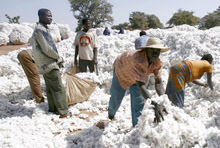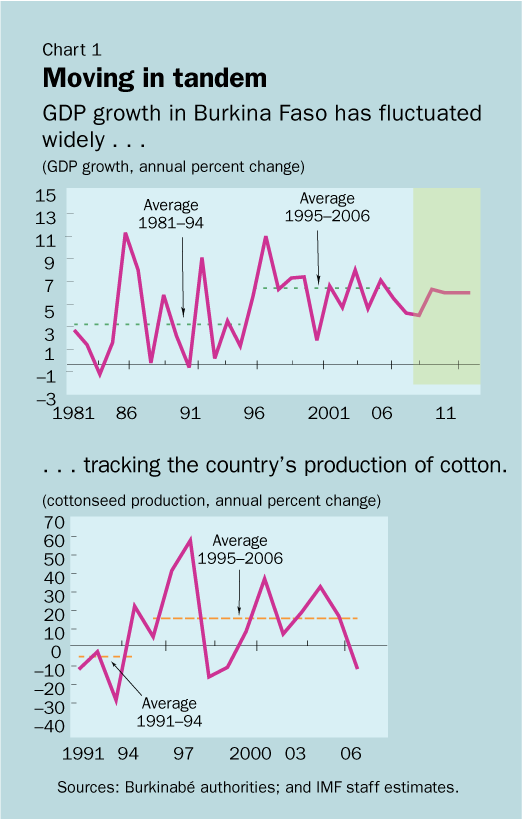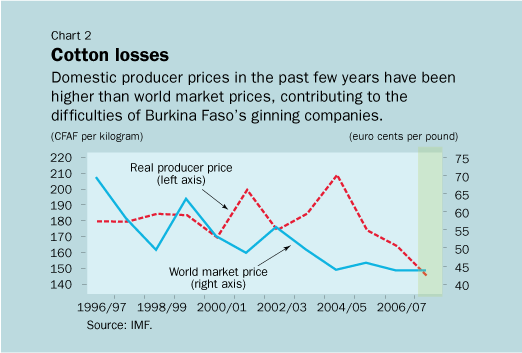
Typical street scene in Santa Ana, El Salvador. (Photo: iStock)
IMF Survey: Tackling Burkina Faso's Cotton Crisis
February 25, 2008
- Production has dropped in Burkina Faso, region's largest producer
- Country must promote advanced techniques, higher-yielding seeds
- Higher productivity, smaller government role will ensure cotton's viability
In Burkina Faso, sub-Saharan Africa's largest cotton producer, cotton production has grown 19 percent a year over the past 10 years, boosting GDP growth (see Chart 1).

Cotton farmers in Pama, central Burkina Faso, were paid less for a kilogram of cotton in the 2007 season than in the 2006 season (photo: ISSOUF SANOGO/AFP/Getty Images).
SSA's largest cotton producer
But the cotton sector has been hurt by lower world prices and the appreciation of the euro (to which the region's CFA franc is pegged) against the dollar. An inappropriate pricing mechanism has further aggravated the difficulties of the ginning companies. Although initiatives to address the problems have begun, more must be done to make the cotton sector more competitive over the long term.

Cotton's economic contribution
Cotton is a major pillar of Burkina Faso's economy. Although it represents only 5-8 percent of GDP, it accounts for 50-60 percent of export earnings and is the main source of foreign exchange. The country's share of world cotton exports has tripled over the past 10 years—unprecedented for an African agricultural product. What makes it more remarkable is the fact that these successes were achieved despite a slump in world prices.
Equally important, in many rural areas where poverty is high, the sale of cottonseed is the main or only source of cash revenue for farmers. It is therefore critical in the fight against poverty.
Cotton provides about 700,000 jobs—mainly for members of farmers' households—or about 17 percent of the population. The expansion of cotton growing has also stimulated increased production of cereals, particularly maize, because fertilizers obtained with the cotton credit are also used for these crops. Poverty has been reduced by a quarter in cotton-growing zones.
Source of the crisis
As in other West African countries, the cotton sector in Burkina Faso is experiencing difficulties. The main reasons are lower world cotton prices and the appreciation of the euro. In addition, because an inflexible pricing mechanism prevented the timely pass-through of lower world cotton prices to producers, the ginning companies, which sell at world prices, incurred sizable financial losses (Chart 2). The largest, SOFITEX, which is partially government owned, incurred losses amounting to more than 1 percent of GDP. The financial difficulties of Burkina Faso's cotton sector are affecting the general economy.

The viability of the sector in Burkina Faso and other West African countries is under pressure from other factors as well, such as the distortions in global cotton trade caused by producer subsidies (especially in the United States and China) and the surge in low-cost output from other developing countries (such as Brazil). Perhaps more important, however, are the low efficiency of ginning companies, low yields, and generally slow productivity growth.
Taking remedial steps
But the actors in the sector have taken the initiative to address the crisis. The authorities recapitalized SOFITEX in 2007 at a cost of more than 1 percent of GDP. The government's share thus increased from 35 percent to more than 60 percent, because the major private shareholder (DAGRIS) did not participate in the recapitalization..
The government is now working with stakeholders and donors to reduce its role in the sector and to rehabilitate SOFITEX and improve its productivity. The two smaller private companies are also being recapitalized.
To ensure the cotton sector's long-term viability, however, efforts to raise productivity and make cotton more competitive are crucial. These efforts will require institutional and policy reforms to disseminate advanced techniques and stimulate use of higher-yielding cottonseeds.
One crucial step toward insuring the sector's viability was the adoption of a market-based producer price-setting mechanism, which was implemented for the 2007/08 harvest. The new mechanism aligns domestic producer prices with world market prices and thus makes producers share part of the risk.
However, to limit excessive price fluctuations for producers, who have little access to credit, the producer floor price is smoothed by basing it on a 5-year centered average of world market prices. A 5.1 percent discount is then applied to the average to protect the smoothing fund, set up to finance major deviations of actual prices from the producer floor price. When world prices are low, the fund makes payments to ginning companies. When world prices rise, the fund is replenished.
The experience with smoothing funds in Africa has not been positive. However, because there are no complete credit, insurance, or futures markets, there could be an economic rationale for this particular fund. But the pricing rules should be improved to ensure that the fund is self-financed under most conceivable scenarios. Donors and domestic cotton stakeholders are working on this. Continuing technical work includes measures to mitigate negative effects on cotton output and farmers' income..
The sector's future
The new pricing mechanism brought the producer floor price down from CFAF 165/kg in 2006/07 to CFAF 145/kg for 2007/08. If current world prices prevail over the next few months, the ginning companies should break even for the fiscal year, and farmers might earn a small bonus from the difference between the floor price and the actual sales price. Cotton output for 2007/08 is expected to fall by more than 25 percent relative to 2006/07 because of bad weather, and production should rebound in 2008/09.
Improving productivity is vital if Burkina Faso cotton is to be competitive. Trials in cultivating high-yield seeds show a productivity gain of 19-30 percent and a gain in income estimated at some $70 per hectare, on average. The challenge now is to get these seeds to producers.
Raising yields will also require a clearer idea of who will pay—and how they will pay—for the cost of research and extension services, knowledge of best cultivation practices, and the ability to design and enforce incentives that may lead farmers to apply technical recommendations.
Market-based hedging strategies should be used to limit financial risks. Theoretically, the use of market-based hedging mechanism is possible not only for Burkina Faso, but for West Africa as a whole. However, many practical problems remain. Currently, recourse to hedging instruments and futures markets is limited in West Africa, but the use of forward sales and exchange rate hedging is possible. The increasing volume of cotton exports from countries other than the United States offers hope for the successful development of world cotton futures contracts.
The role of the Burkinabè government in the cotton sector should be reduced over time. One of the lessons of the crisis is that SOFITEX poses a risk to the financial viability of the sector because of its weight (85 percent of production). Over the medium term, consideration could be given to rebalancing the relative weight of different cotton companies.
Moreover, as a large shareholder of SOFITEX, the government must intervene if there is a shock; this has been a significant drain on the national budget. The government has approved a strategy to reduce its stake in SOFITEX so that it can function effectively as a private company. Reducing the role of government does not necessarily mean it will fully disengage from the sector. For example, there is also an important regulatory role, because capacity and institutional structures are inadequate.
Comments on this article should be sent to imfsurvey@imf.org


